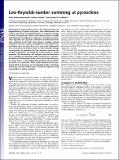Low-Reynolds-number swimming at pycnoclines
Author(s)
Stocker, Roman; Doostmohammadi, Amin; Ardekani, Arezoo M.
DownloadStocker_Low-Reynolds-number.pdf (2.222Mb)
PUBLISHER_POLICY
Publisher Policy
Article is made available in accordance with the publisher's policy and may be subject to US copyright law. Please refer to the publisher's site for terms of use.
Terms of use
Metadata
Show full item recordAbstract
Microorganisms play pivotal functions in the trophic dynamics and biogeochemistry of aquatic ecosystems. Their concentrations and activities often peak at localized hotspots, an important example of which are pycnoclines, where water density increases sharply with depth due to gradients in temperature or salinity. At pycnoclines organisms are exposed to different environmental conditions compared to the bulk water column, including reduced turbulence, slow mass transfer, and high particle and predator concentrations. Here we show that, at an even more fundamental level, the density stratification itself can affect microbial ecology at pycnoclines, by quenching the flow signature, increasing the energetic expenditure, and stifling the nutrient uptake of motile organisms. We demonstrate this through numerical simulations of an archetypal low-Reynolds-number swimmer, the “squirmer.” We identify the Richardson number—the ratio of buoyancy forces to viscous forces—as the fundamental parameter that quantifies the effects of stratification. These results demonstrate an unexpected effect of buoyancy on low-Reynolds-number swimming, potentially affecting a broad range of abundant organisms living at pycnoclines in oceans and lakes.
Date issued
2012-02Department
Massachusetts Institute of Technology. Department of Civil and Environmental Engineering; Parsons Laboratory for Environmental Science and Engineering (Massachusetts Institute of Technology)Journal
Proceedings of the National Academy of Sciences of the United States of America
Publisher
National Academy of Sciences (U.S.)
Citation
Doostmohammadi, A., R. Stocker, and A. M. Ardekani. “Low-Reynolds-number Swimming at Pycnoclines.” Proceedings of the National Academy of Sciences 109.10 (2012): 3856–3861. © 2012 National Academy of Sciences
Version: Final published version
ISSN
0027-8424
1091-6490